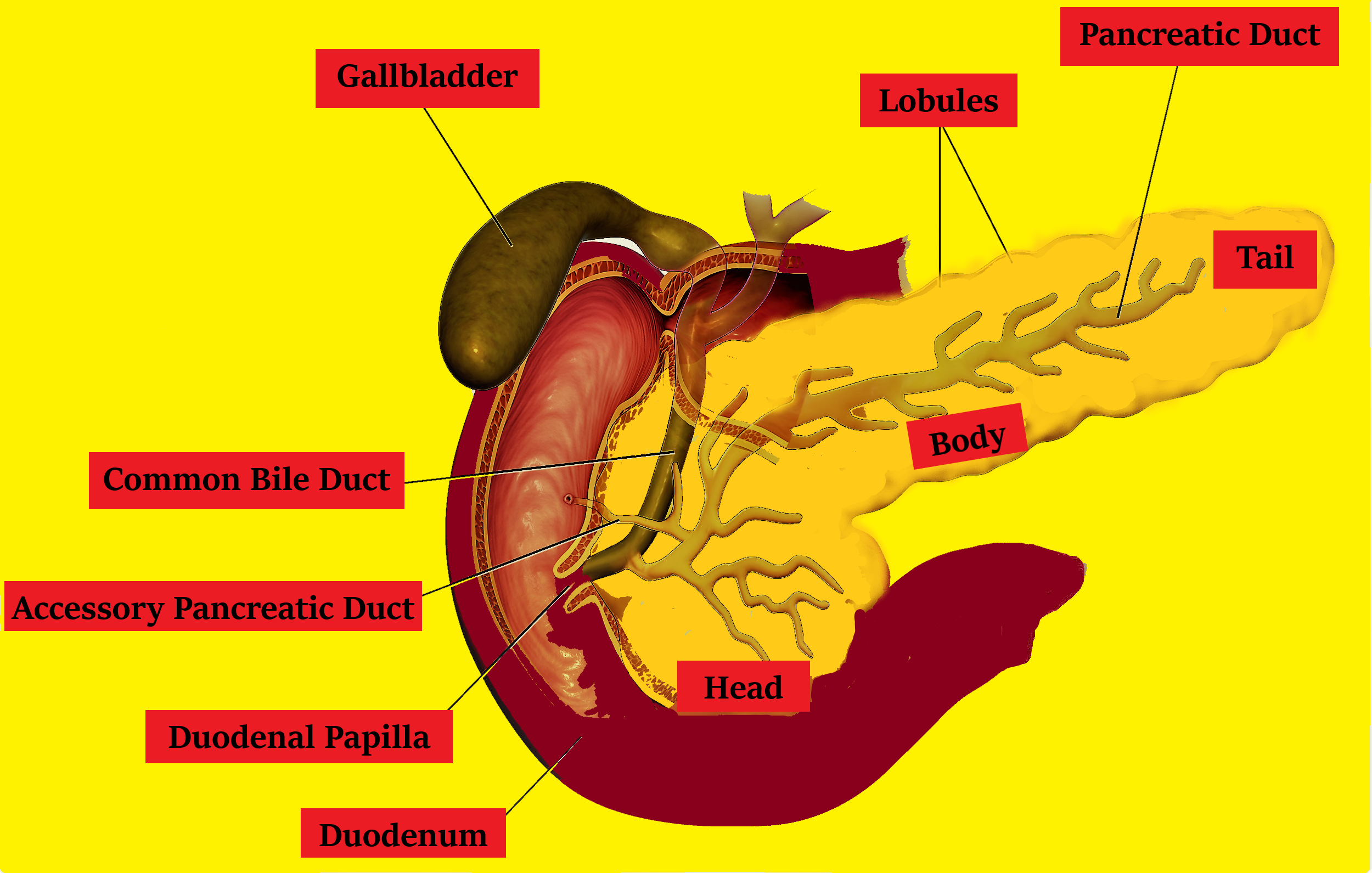
If the pancreas is removed, the compound which remains undigested is
(a) Carbohydrates
(b) fats
(c) Proteins
(d) All
Answer
453k+ views
Hint: The pancreas is an accessory digestive gland that aids in the process of digestion. It secretes pancreatic juice which is filled with digestive enzymes that helps in the conversion of complex molecules into their simpler molecules.
Complete answer:
The pancreas is located in the abdomen near the stomach and duodenum of the small intestine. It produces digestive enzymes that transform complex molecules into their much shorter and simpler components. Pancreas juice released into the duodenum contains pancreatic amylase, trypsin, chymotrypsin, carboxypeptidase, lipase, and pancreatic nuclease that assist the body to digest fats, proteins, and carbohydrates. If the pancreas is removed from the body, all these biomolecules will remain undigested.
Additional Information:
- The exocrine portion of the pancreas produces pancreatic juice which contains enzymes essential for digestion. These enzymes include pancreatic amylase, trypsin, chymotrypsin, carboxypeptidase, lipase, and pancreatic nuclease.

- Pancreatic amylase acts on polysaccharides in the chyme and breaks them into disaccharides.
- Likewise, trypsin and chymotrypsin are proteases whose substrates are proteins and polypeptides which are converted into much smaller peptide fragments.
- Carboxypeptidase further attacks these peptide fragments in the lumen of the small intestine to convert them into individual amino acids.
- Lipase aids in fat digestion by helping in the breakdown of triglycerides into free fatty acids and monoglycerides.
- Pancreatic nucleases cleave DNA and RNA into their individual building blocks which are nucleotides.
- The pancreatic juice is released into the pancreatic duct, which upon exiting, merges with the bile duct from the liver and gallbladder. It opens into the first portion of the small intestine.
So, the correct answer is ‘(d) All.’
Note: The islets of Langerhans consist of endocrine cells of the pancreas that release hormones directly into the bloodstream. Insulin and glucagon are two of those important hormones.
Insulin and glucagon are antagonistic to each other i.e their function and effects are opposite to each other. Insulin acts to lower blood sugar while glucagon acts to increase blood sugar.
Complete answer:
The pancreas is located in the abdomen near the stomach and duodenum of the small intestine. It produces digestive enzymes that transform complex molecules into their much shorter and simpler components. Pancreas juice released into the duodenum contains pancreatic amylase, trypsin, chymotrypsin, carboxypeptidase, lipase, and pancreatic nuclease that assist the body to digest fats, proteins, and carbohydrates. If the pancreas is removed from the body, all these biomolecules will remain undigested.
Additional Information:
- The exocrine portion of the pancreas produces pancreatic juice which contains enzymes essential for digestion. These enzymes include pancreatic amylase, trypsin, chymotrypsin, carboxypeptidase, lipase, and pancreatic nuclease.

- Pancreatic amylase acts on polysaccharides in the chyme and breaks them into disaccharides.
- Likewise, trypsin and chymotrypsin are proteases whose substrates are proteins and polypeptides which are converted into much smaller peptide fragments.
- Carboxypeptidase further attacks these peptide fragments in the lumen of the small intestine to convert them into individual amino acids.
- Lipase aids in fat digestion by helping in the breakdown of triglycerides into free fatty acids and monoglycerides.
- Pancreatic nucleases cleave DNA and RNA into their individual building blocks which are nucleotides.
- The pancreatic juice is released into the pancreatic duct, which upon exiting, merges with the bile duct from the liver and gallbladder. It opens into the first portion of the small intestine.
So, the correct answer is ‘(d) All.’
Note: The islets of Langerhans consist of endocrine cells of the pancreas that release hormones directly into the bloodstream. Insulin and glucagon are two of those important hormones.
Insulin and glucagon are antagonistic to each other i.e their function and effects are opposite to each other. Insulin acts to lower blood sugar while glucagon acts to increase blood sugar.
Recently Updated Pages
Can anyone list 10 advantages and disadvantages of friction

What are the Components of Financial System?

How do you arrange NH4 + BF3 H2O C2H2 in increasing class 11 chemistry CBSE

Is H mCT and q mCT the same thing If so which is more class 11 chemistry CBSE

What are the possible quantum number for the last outermost class 11 chemistry CBSE

Is C2 paramagnetic or diamagnetic class 11 chemistry CBSE

Trending doubts
Which is not a source of freshwater 1 Glaciers and class 11 chemistry CBSE

10 examples of friction in our daily life

The correct order of melting point of 14th group elements class 11 chemistry CBSE

Difference Between Prokaryotic Cells and Eukaryotic Cells

One Metric ton is equal to kg A 10000 B 1000 C 100 class 11 physics CBSE

What is the specific heat capacity of ice water and class 11 physics CBSE




